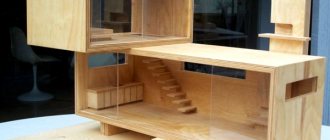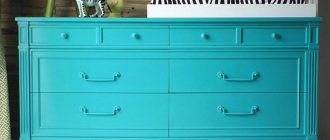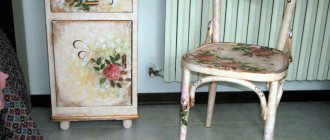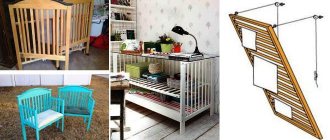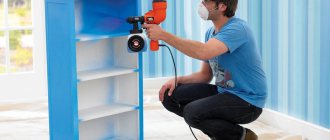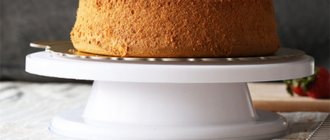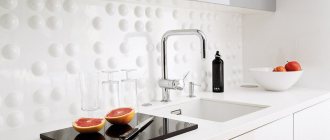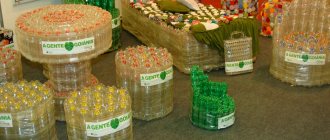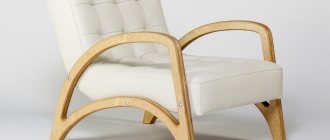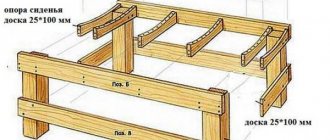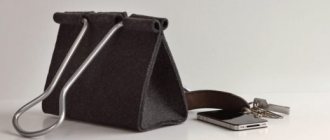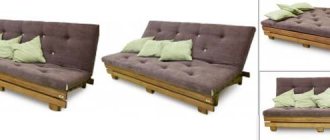What should you take care of before making furniture?
When assembling furniture with your own hands, you need to think in advance about the appearance of the object and decide in which part of the apartment it will be placed. This data will allow you to determine the most suitable materials and accessories. Drawings are another important component of the process. After creating sketches with parameters and purchasing tools and building materials, you can begin the actual installation. It is better to strictly adhere to the original idea and pay attention to all calculations, otherwise furniture made by yourself may turn out to be sloppy.
The most important thing in furniture making is the drawing.
How to make chipboard at home?
We must immediately define the concept of “home conditions”.
This formulation also includes a “corner” in the kitchen and a mansion with a plot of several hectares.
If it is possible to locate a workshop for the production of chipboards in the local area, then, in principle, production is possible in such “home conditions”.
If you mean an apartment, or a small house, then there are no options at all, because the production of chipboard is a method of “hot” pressing of chips (wood) with the addition of resin.
That is, in addition to everything, you need press-to-press mixers with dispensers, forming machines, coolers, automatic cutting machines for finished sheets, drying drums, grinding machines, wood waste crushers, and so on.
The equipment is different, but in general it is dimensional equipment
There is no way to make chipboard “on the knee” (we read, ordinary home conditions, or even garage conditions), it is not technologically possible.
There is no way for this process, other than the components that are, in principle, available, you also need to have an industrial high-temperature press, which simply will not fit into the house))
Chipboard is wood chipboards that are produced in special factories. To make chipboard at home, you need to create a workshop or a small enterprise for the production of chipboard, because making chipboard involves mixing sawdust with an adhesive material, such as an agent, then this must be pressed at high pressure and high temperature.
To make chipboard, you need mixers, thanks to which a homogeneous mass is obtained from sawdust, as well as from an adhesive material.
Also, you need a special apparatus to give the sawdust and adhesive material the desired shape, the next step is to press the sawdust, for this you need a press with hot air. After the press, the chipboard needs to be cooled; a special machine is needed for cooling, after which the future chipboard is cut and sanded, quality checked, laminated, and only then prepared for sale or used for making furniture.
To make chipboard, you need not only special equipment, you also need to know how to make chipboard correctly, and you also need a license for its production and a certificate.
If you decide to make it at home, then for this you need to at least have a small room, a press, you need to mix sawdust in small containers, 15-20 liter containers would be an excellent option, then you need to add a binder to the sawdust to give the desired form, a press is used to obtain the desired shapes, the next step is to cool the product and cut it.
Once the product has cooled, a laminated film can be applied to it.
To make wood at home, you need to spend a lot of money to buy special equipment.
Source
Furniture fittings
An important element is furniture fittings
Fittings are small but important elements, without which the furniture will not be able to perform its functions. You should not save on this part, since the service life and overall level of performance of the future structure, assembled with your own hands, depend on the quality of the purchased fittings.
Furniture handles are attached with screws. Guides (roller and telescopic, or ball) play an important role when assembling drawers, as they give them the correct direction of movement.
To soften the impact when closing and reduce the noise level, silicone dampers are installed on the inside of furniture doors (or the end). Legs are an optional detail, but in some cases they can greatly extend the life of furniture and adjust its optimal position on an uneven floor.
Hinges affect the degree to which drawer doors open. The standard is 180° for opening and 90° for closing. If the manufacturer has not made additives (cutouts for hinges), then they can be added in any furniture workshop. For doors made of glass, you need to purchase special hinges that can hold it without drilling holes.
Furniture fasteners
Fasteners and their types require special attention. These are metal products that are ultimately of decisive importance for furniture, since they provide its strength, geometric correctness and stability.
Wooden dowels
They are used for preliminary and intermediate fixation and to increase the shear load. The dowels are inserted into drilled holes in both pieces of furniture to be fastened together. Later, the parts are attached using a more reliable method.
Fastening dowels
Iron corners
A slightly outdated fastening system, which fully justifies its cheapness with its unattractive appearance, bulkiness and loosening after some time.
Types of iron corners
Confirmat, or furniture screw
A modern fastening element that has replaced conventional self-tapping screws thanks to large threads: because of this, the screws hold tighter in the chipboard. The main disadvantages of this type are the need to use a special drill with different diameters for threading, the head and neck of the Euroscrew, as well as the heads that remain visible. The master will have to select plastic plugs to match the color of the furniture body.
Eccentric couplers
One of the most popular fastening methods today. The main advantage of eccentric couplers is that they leave drilling marks only on the inside of the product. For this fastening you will need the aforementioned Forstner drill. The method is labor-intensive and perfect for sliding furniture doors. In other cases, it is worth focusing on simpler and less expensive options.
Eccentric couplers
How to make a liquid tree with your own hands
Although they say that liquid wood is a new modern material, it was used back in Soviet times.
Only it was not sawdust that was used, but wood dust - putty was made from it and holes, cracks, and chips in various wooden products were sealed.
Nowadays, liquid wood is made from sawdust, wood chips and shavings.
At home, to prepare “liquid wood” material for crafts, it is easier to take sawdust and PVA glue.
The mass is mixed, left for about ten minutes and can be tinkered with or poured into a mold.
True, PVA glue has several disadvantages:
- it is not transparent, so it is not suitable for everything - in jars it is too thick and you have to stir it with water.
I. Advantages of PVA:
- after hardening, the manufactured products are very durable - both in liquid and frozen states it is completely safe, because does not emit any toxic substances - burns very poorly
Epoxy gives transparency and beautiful color to products using the “liquid wood” technique.
The downside is
that you can only work with it in a well-ventilated area, since the resin is toxic.
Polyester resin
is less toxic, but just like epoxy, it shrinks strongly when it hardens and this should be taken into account when making any crafts.
So, everything is clear with “kneading” liquid wood. Let's move on to the forms.
You can use silicone molds to make boards, parquet slabs, figurines, and sculptures. (This, of course, is not all of the things listed that can be done) If we make it from a mixture of sawdust, shavings and epoxy, then the mixture must be heated from 40 to 60 degrees and quickly poured into the mold.
The mixture in a liquid state will “live” for up to 20 minutes, then the hardening process will begin.
Next, you need to correctly remove the finished product from the mold:
- silicone mold, bend it at the edges, turn it over and start removing it, carefully holding the finished mold. - rigid form, also turn it over and lightly tap the entire bottom with your fingers so that the vibration causes the product to move away from the mold.
The latter is processing with a file or sandpaper.
Using sandpaper and a file, we remove defects or irregularities.
By the way, before pouring the “liquid wood” into the molds, make a small portion of the mixture, about 100 ml. This will determine not only the correct proportions, but also the strength and appearance of the finished product.
Liquid wood is an ideal material for repairing various surfaces made of chipboard, MFD, chipboard and wood of any species.
In their practice, “liquid wood” was used to repair pine cuts.
Improper drying led to several cuts being torn. I had to, and it turned out to be a good idea, to seal the holes with liquid wood - a mixture of small sawdust and PVA, then simply sand the patches. And no one noticed!
Afterwards we repaired the countertop - it turned out great.
After the liquid wood patches had dried, they covered everything with varnish. True, before this we again went through a little sandpaper and colored it to match the main color of the tabletop.
Source
Selection of edges and furniture fronts
These elements perform an aesthetic function, so you need to choose them wisely. Making beautiful cabinet furniture that will look expensive is not difficult if you carefully select decorative parts.
Edge
The protection of the cuts of the body slabs, and, consequently, the strength of the furniture depends on the correct choice of this part. If you do not take care of high-quality insulation, moisture can easily penetrate the furniture structure and destroy it from the inside.
There are several options, one of the best for making furniture with your own hands is PVC edging. This finishing does not require special skills or professional equipment. Standard sizes: 0.4 and 2 mm. To save money, a thin edge is glued to the ends that are inaccessible to the eye, and a 2 mm edge is glued to the outer edges, which will be subject to heavy loads and friction.
Other advantages of this type of furniture finishing:
Edge thickness comparison
- Melamine edging: cheap but impractical option. Glued using a regular iron.
- ABS is similar to PVC, but made from an environmentally friendly material.
- The overlay U-profile is glued to liquid nails. Impractical due to the accumulation of dirt at the joint, but helps hide the defects of a bad cut.
- Mortise T-profile - rarely used, inserted into a groove made by a milling cutter.
Front part of furniture
Kitchen fronts and drawer doors are the “face” of the furniture, so they should look much more presentable than other details that are not so striking. Making this element yourself means saving time, since such things are usually made to order, and the wait can take several months.
Scheme of the front part of the furniture
As for the technical details, the façade part is standardly manufactured 2 mm smaller on each side of the main body. So, for furniture with a width of 600 mm, a façade whose width is 596 mm is suitable. The raw materials of the decorative part are different from those of the main body.
Among the cheapest facades are laminated MDF panels with a short service life. Mostly wood finishes are found. Softforming, which is gaining popularity, is similar to MDF, but differs in a two-color layout and relief on both sides of the panel. Such furniture is suitable exclusively for dry rooms (bedroom, living room). You can often see non-standard facades with curly stained glass cutouts. The glass is usually attached to the lining on the inside of the door.
Postforming
This is the implementation of high-quality, durable decor. It is distinguished by the severity of its forms and is performed without aesthetic frills. The basis is MDF or chipboards, which are covered with thin, seamless plastic. A plastic facade is another expensive, but extremely practical option.
Characteristics:
- smooth surface (glossy, matte);
- laconic design;
- ABS edge or aluminum profile.
At the peak of popularity now are super-glossy acrylic panels for making furniture with your own hands.
Wood and veneer
Expensive but natural materials. There is an opinion that from an environmental point of view, the option loses, since it contains a lot of varnish and impregnations. Painted facades “like enamel” are becoming increasingly rare. The rich color, which was so valued before, has also appeared in competitors, for example, acrylic. A significant disadvantage of such furniture is that it is not resistant to deformation and scratches.
Aluminum-glass facades
The optimal method for making furniture with your own hands in high-tech style.
Scheme of an aluminum-glass facade
What it is?
Chipboard is a sheet composite material produced by pressing sawdust and shavings at high temperatures with a non-mineral binder and the introduction of various additives, which are necessary in various cases to improve certain properties of the resulting sheet. The production of this material is quite expensive, but at current prices for the finished product, the purchased equipment pays for itself in 1-2 years.
Depending on different indicators, there are several classifications of chipboard. Some classifications are given below.
Main types
The CIS GOST documentation identifies the following characteristics for classification:
- Based on the number of layers, chipboard is divided into single-layer, two-layer, three-layer and multi-layer. Moreover, the trend is this: the greater the number of layers, the more dense and durable the resulting slab.
- By emission class. Emission determines the amount of formaldehyde that, when added during production, is released into the air from 100 g of slab. There are 2 classes: E1 and E2, while the first is more environmentally friendly, harmless to people, the content of harmful substances in it is less than 10 mg. Another class contains more than 10 mg of formaldehyde. Boards of this class are suitable for use in construction and production with good ventilation or outdoors. There is also a certificate for chipboard that confirms its emission class. The certificate is issued by a special body, has an established model and is distributed throughout the CIS. The current standards for assessing the toxicity of formaldehyde in Europe differ from those adopted in the CIS countries.
- Based on the density of chipboard, slabs are distinguished with low density (550 kg/m³), with medium density - 550–750 kg/m³, with high density - more than 750 kg/m³.
Preparation of drawings for furniture manufacturing
Assembly drawings are a personal guide during the work process. If you pay due attention to this part at the preparatory stage, then the master will not have to frantically make calculations and be afraid of attaching something in the wrong place. You can make the assembly task easier for yourself by sketching everything out on a simple sheet of paper by hand or using special computer programs.
It should be remembered that the drawing must be clear and readable at least for the person who will be assembling the furniture.
Furniture drawing
Calculation and detailing
Calculation and detailing of furniture
It is impossible to make cabinet furniture with your own hands without taking into account the consumption of materials. This stage requires drawing up a detailed list of what material each part will be made of, indicating its parameters. The sheet is sent to the nearest accessible workshop, where all elements will be sawn and initially processed (edge).
The list should include consumables for the case, fittings, and fasteners. This way you can easily calculate the final cost of the furniture, taking into account the services of the workshop. The price of an item made with your own hands at home is 30–35% less than the retail price in stores.
Furniture assembly technology
You should start constructing any furniture with your own hands from the main frame, that is, from the largest parts, gradually adding small ones. An example of assembling a bookcase:
Furniture assembly
- After the preparatory stage, the side, top and bottom walls of the frame are connected and the diagonal is aligned.
- Then the fiberboard back is attached using self-tapping screws.
- The third stage is fastening the shelves. Confirmats guarantee a stronger connection.
- Places on the side walls on the outside that have been damaged by hardware can be decorated with matching color-matched plugs.
- Now it’s the turn of additional internal parts, for example, shelves may have drawers (additional partitions).
- The last to be installed are the decorative parts (linings, façade, etc.).
Beds, kitchen cabinets, wardrobes and other home furniture are assembled using the same scheme. When using hazardous electrical equipment, generally accepted safety precautions are observed.
In order to make furniture yourself, you need to have the desire, a little care, time and basic knowledge in the field of construction. If everything is done correctly, the end result will be an exclusive and functional piece of decor that will last for many years and will fit perfectly into the interior of the apartment.
How can you use sawdust?
Sawdust is a unique material that has many of the properties of wood . Therefore, such material is in great demand in:
- fuel production;
- production of building materials;
- home and agriculture;
- repair and construction work.
Fuel production
Various types of fuel are obtained from sawdust, among which the most famous are pellets and briquettes .
These types of fuel can be used for conventional boilers, stoves or fireplaces, but the maximum effect is achieved only in automatic heating devices .
After all, all elements of one batch are identical in size and shape, thanks to which automatic fuel supply systems can dose them more accurately. Read more about these types of fuel here.
Another popular type of fuel is a mixture of various alcohols , which is obtained from fermented sawdust.
This material is mixed with a sulfuric acid solution and heated under pressure, causing the cellulose to break down into simple sugars that can be fermented.
After fermentation is complete, the mass is passed through a distiller, resulting in alcohols of various qualities .
Read more about this use of sawdust in a separate article.
pyrolysis gas is obtained from sawdust , suitable for use in heating and kitchen stoves, as well as in hot water boilers and other natural gas-powered equipment.
In terms of calorific value, pyrolysis gas is much inferior to natural gas, but, due to the minimal cost of its production, heating with pyrolysis gas is often cheaper than with natural gas.
Read more about this gas, the method of its production and use here.
Manufacturing of building materials
Sawdust is used to produce building materials such as sawdust concrete.
Compared to ordinary concrete, this material is noticeably lighter, and also has lower thermal conductivity , so a house built from it loses less heat, which means you will have to spend less on additional insulation.
In addition, wood in concrete improves the vapor permeability of walls , due to which such houses always have optimal humidity, because its excess goes through the walls to the street.
You can read more about this material here.
Another popular material made from sawdust is wood concrete. In many ways it is similar to sawdust concrete, but it also has differences. After all, the mixture for pouring wood concrete is prepared without adding sand, that is, by mixing cement, sawdust and water.
In addition, this material is lighter and stronger than sawdust concrete, although it is much more expensive. You can read in more detail about the production and use of wood concrete in this article.
insulation and finishing materials are made from sawdust :
- Fiberboard (fibreboard);
- Chipboard (chipboard);
- organic insulation.
Fiberboard is used for finishing walls, ceilings and floors, as well as for lining the interior of cabinets.
On the basis of fiberboard, a popular finishing material is made - hardboard, which differs from fiberboard by the presence of a decoratively treated side. Chipboard is used to create furniture and many other works.
Organic insulation is only slightly inferior to mineral wool, but environmentally friendly , because its basis is paper obtained from sawdust.
Household and Agriculture
Sawdust is an excellent material for feeding various animals . This applies to both pets, such as hamsters, parrots or cats, and various livestock.
The material for backfill is chosen based on many factors, one of which is smell, because fresh sawdust has a strong smell, and not everyone likes it.
For more information on how to choose bedding, read the article (Sawdust for pets).
Another use for this material is mulching the ground around plants.
Bare soil quickly loses moisture, overheats and cools, causing plant roots to suffer. By filling the soil around the plant with waste from sawing wood, you will protect the roots, which will make the plant better able to withstand winter cold and summer heat, and it will also be possible to water it less often.
Wood sawing waste is an excellent material for growing mushrooms and creating high-quality fertilizer . Mushrooms receive enough nutrition from them to multiply quickly, and the cost of such food is low, and you can often get it for free.
Sawdust also produces good humus , which saturates the soil with nutrients and increases plant productivity.
To learn more about this method of using wood sawing waste, read the article (Fertilizer from sawdust) . It is also very convenient to cover paths between beds in fields, vegetable gardens or greenhouses with sawmill waste.
Even after heavy rains, you can walk along such paths without getting smeared with mud , so you can check the plants after a rainstorm.
Once every few years you will need to plow the garden or field so that the sawdust is evenly distributed over the ground and fertilizes it.
Repair and construction work
The main use of sawdust during repair and construction work is various insulation .
They are poured between thin wooden walls, due to which, at minimal cost, the thermal conductivity of such a wall is comparable to the same parameter of a wall made of timber of the same width.
That is, with a wall width of 20–30 cm, insulation will be required only in the northern regions.
In addition, wood sawing waste is mixed with clay and the resulting solution is used to insulate ceilings, floors and brick walls.
The effectiveness of such insulation is much lower than that achieved by using mineral wool or polystyrene foam , but the thickness of the layer can be increased, which results in significant savings.
The same compositions are made on the basis of lime or cement, which act as a binder. Read more about all the methods of insulation using wood sawing waste here (Insulation with sawdust).
